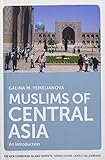Muslims of Central Asia : An Introduction / Galina Yemelianova.
Material type: TextSeries: The New Edinburgh Islamic Surveys : NEISPublisher: Edinburgh : Edinburgh University Press, [2022]Copyright date: ©2019Description: 1 online resource (240 p.) : 25 B/W illustrationsContent type:
TextSeries: The New Edinburgh Islamic Surveys : NEISPublisher: Edinburgh : Edinburgh University Press, [2022]Copyright date: ©2019Description: 1 online resource (240 p.) : 25 B/W illustrationsContent type: - 9781474416320
- 9781474416344
- online - DeGruyter
| Item type | Current library | Call number | URL | Status | Notes | Barcode | |
|---|---|---|---|---|---|---|---|
 eBook
eBook
|
Biblioteca "Angelicum" Pont. Univ. S.Tommaso d'Aquino Nuvola online | online - DeGruyter (Browse shelf(Opens below)) | Online access | Not for loan (Accesso limitato) | Accesso per gli utenti autorizzati / Access for authorized users | (dgr)9781474416344 |
Frontmatter -- Contents -- Figures -- Acknowledgements -- Note on transliteration -- Abbreviations and acronyms -- Glossary -- Introduction -- PART I Central Asia in the pre-Russian, Russian and Soviet periods -- CHAPTER 1 Muslims of Central Asia before the Russian conquest -- CHAPTER 2 The Russian conquest and rule of Central Asia -- CHAPTER 3 The Sovietisation of Central Asian Muslims -- PART II Central Asian Muslims after independence -- CHAPTER 4 Muslims of Uzbekistan -- CHAPTER 5 Muslims of Kazakhstan -- CHAPTER 6 Muslims of Kyrgyzstan -- CHAPTER 7 Muslims of Tajikistan -- CHAPTER 8 Muslims of Turkmenistan -- Conclusion -- Bibliography -- Index
restricted access online access with authorization star
http://purl.org/coar/access_right/c_16ec
The first history-based integrated overview of Islam and Muslims in present-day Central AsiaBetween the tenth and sixteenth centuries Central Asia was one of the most prestigious cultural areas of the entire Muslim world, playing a pivotal role in the Silk Road trade. Throughout that history, and up to the present, Tajiks, Uzbeks, Kazakhs, Kyrgyz, Turkmen and other Muslim peoples of Central Asia have developed their own unique understanding and practice of Islam which has shaped their national identity and particular social and political evolution. These special characteristics of Central Asian Islam ensured its survival during seventy years of Soviet atheist rule, while in the post-Soviet period Islam has been integrated into nation-building projects in constitutionally secular Uzbekistan, Kazakhstan, Tajikistan, Kyrgyzstan and Turkmenistan.This absorbing history is traced in this fascinating study which shows how, from the seventh century to the present day, the region’s people have negotiated their distinctively Central Asian Islamic identity in the face of enduring external Islamic and non-Islamic dominations, ethnic nationalisms and, more recently, global transnational Islamic influences.Key FeaturesThe first integrated account of the Muslims of the present-day states of Uzbekistan, Kazakhstan, Kyrgyzstan, Tajikistan and Turkmenistan Synthesises up-to-date research with existing Western, Russian and Central Asian scholarship on Islam and Muslims in Central Asia Employs a Central Asia-centric approach focusing on the region as a geographically and culturally self-sustained entity, with strong links to Russia, the Middle East, South Asia, Iran, Turkey and ChinaIncludes numerous photographs taken during field-work in Uzbekistan, Tajikistan, Kazakhstan and Kyrgyzstan
Mode of access: Internet via World Wide Web.
In English.
Description based on online resource; title from PDF title page (publisher's Web site, viewed 29. Jun 2022)


